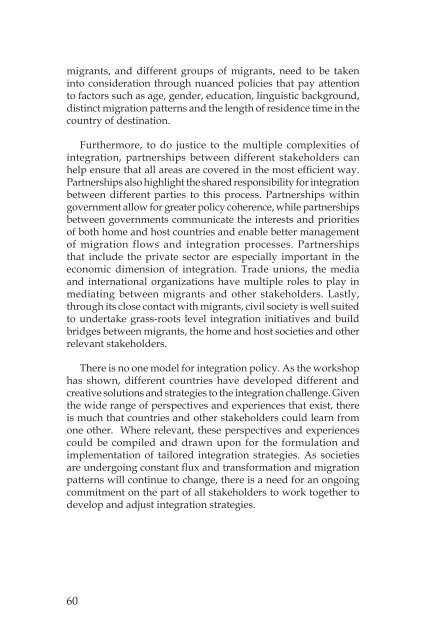Link - IOM Publications - International Organization for Migration
Link - IOM Publications - International Organization for Migration
Link - IOM Publications - International Organization for Migration
Create successful ePaper yourself
Turn your PDF publications into a flip-book with our unique Google optimized e-Paper software.
migrants, and different groups of migrants, need to be taken<br />
into consideration through nuanced policies that pay attention<br />
to factors such as age, gender, education, linguistic background,<br />
distinct migration patterns and the length of residence time in the<br />
country of destination.<br />
Furthermore, to do justice to the multiple complexities of<br />
integration, partnerships between different stakeholders can<br />
help ensure that all areas are covered in the most efficient way.<br />
Partnerships also highlight the shared responsibility <strong>for</strong> integration<br />
between different parties to this process. Partnerships within<br />
government allow <strong>for</strong> greater policy coherence, while partnerships<br />
between governments communicate the interests and priorities<br />
of both home and host countries and enable better management<br />
of migration flows and integration processes. Partnerships<br />
that include the private sector are especially important in the<br />
economic dimension of integration. Trade unions, the media<br />
and international organizations have multiple roles to play in<br />
mediating between migrants and other stakeholders. lastly,<br />
through its close contact with migrants, civil society is well suited<br />
to undertake grass-roots level integration initiatives and build<br />
bridges between migrants, the home and host societies and other<br />
relevant stakeholders.<br />
There is no one model <strong>for</strong> integration policy. As the workshop<br />
has shown, different countries have developed different and<br />
creative solutions and strategies to the integration challenge. Given<br />
the wide range of perspectives and experiences that exist, there<br />
is much that countries and other stakeholders could learn from<br />
one other. Where relevant, these perspectives and experiences<br />
could be compiled and drawn upon <strong>for</strong> the <strong>for</strong>mulation and<br />
implementation of tailored integration strategies. As societies<br />
are undergoing constant flux and trans<strong>for</strong>mation and migration<br />
patterns will continue to change, there is a need <strong>for</strong> an ongoing<br />
commitment on the part of all stakeholders to work together to<br />
develop and adjust integration strategies.<br />
60

















